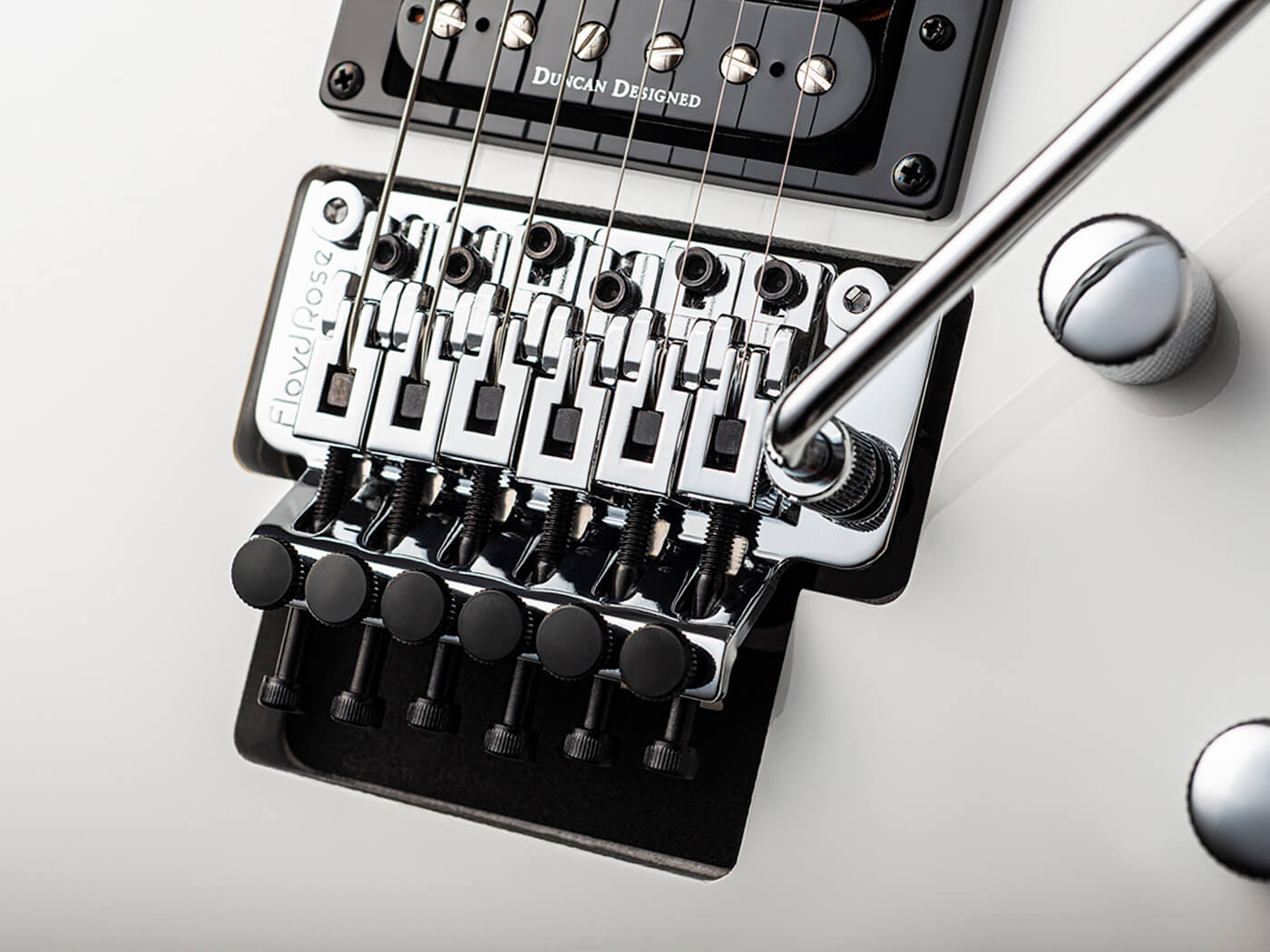A Brief History of Floyd Rose
You’ve probably played a guitar with one of his vibratos on, but what do you actually know about the man behind the Floyd?

A Floyd Rose on a Kramer guitar
There are a few innovators whose contribution to the guitar world is so impactful and lasting that it changes the way the instrument can be played – Floyd D Rose is one of those innovators.
Like many musical inventors, Floyd was a working musician prior to getting involved in the making of musical equipment – unusually however, he kept working and playing in bands, most notably Seattle hard-rock band Q5 in the 1980s. But for Floyd’s greatest contribution to the guitar, we have to go back to the 1970s.
- READ MORE: A Brief History Of Peavey Electronics
The 70s were not a particularly great time in the history of Fender or Gibson. The decade was encompassed by Fender’s CBS era, and Gibson’s Norlin Era – a time when production quality saw a noticeable dip and other manufacturers started making copies that rivaled the quality of guitars the big two were making at the time.
Of course, there were a lot of reasons for this and consequences of this, but the reality for the working musicians like Floyd D Rose was the constant issues regarding their instruments’ stability – most notably, tuning stability.
Early in the decade, Rose was using a 1963 Stratocaster with a 1957 neck. As he tried to emulate his whammy-wangling heroes Jimi Hendrix and Ritchie Blackmore, Rose noticed that he was snapping tremolo arms off on a nearly weekly basis, and his guitars refused to stay in tune after using the tremolo arm. He made his own custom steel tremolo arm and loosened the six screws fastening the stock Fender bridges to the body, thus allowing him to have a larger range of pitch bending. But, as they say, mo’ pitch bending, mo’ tuning stability problems.

Nut Of The Problem
Rose was able to pinpoint the problem at the nut of his guitar. When stretching the strings, Rose found that each string would move through the nut, and sometimes it would get caught in the nut slot, making that string go sharp. He surmised that if he could just lock the string in place at the nut, he would no longer have tuning issues when using the tremolo arm.
His first attempt to lock the string in place involved Krazy Glue. No really. This incredibly bad-sounding idea apparently worked… sort of… but it was enough to warrant looking into the theory further.
In addition to his side gig as a working musician, Rose had a day job as a jeweller and had access to various professional lapidary tools – machines and implements used for cutting and shaping stones and gems. While they certainly weren’t intended for this function, Rose was able to use these tools to make a brass nut that had three clamps on top to lock the strings in place.
The locking nut worked well enough to convince his parents to loan him $600 to have a machine shop develop what Rose considers to be the first real model of the Floyd Rose Locking Tremolo System in 1976 from these initial prototypes. The first system was made of brass and wasn’t very strong, so he had another model made out of hardened steel – this version also featured a locking bridge as well as a locking nut.

Locked It Down
Before long, the original hand-made Floyd Rose Locking Tremolo Systems wound up in the hands of forward thinking players like Brad Gillis, Neil Schon, Steve Vai, and Alex Lifeson, who all installed early versions of the system on their own guitars. In 1980, the Floyd Rose system found its way into the hands of Eddie Van Halen, who affixed it to his Frankenstrat. After that, demand skyrocketed, making the Floyd Rose a household name among guitar players in the ensuing years.
The Floyd Rose and the other locking tremolo systems that followed completely changed the face of popular music and gave rise to the shred guitar that dominated the rock scene in the 1980s. Rose got a patent on his design in 1979, and shortly after, he licensed it to a relatively new company, Kramer Guitars, in order to keep up with the exploding demand for units. The original production units were made by Fernandes Guitars, but other licensing agreements were given out to other manufacturers, leading to several versions of the Floyd Rose.
However, users of the system noticed a flaw in the original design – once the strings were locked in place at the nut, it was not possible to tune the guitar without unlocking the whole thing, and despite excellent tuning stability overall, time and physics eventually meant that strings would go out of tune.
In response, the design was altered and the Floyd Rose reached its final form that we know today, with a series of fine-tuning wheels at the bridge – a feature that remains in place to this day. There were some other less overt changes too – for example some tone-aficionados complained that the system didn’t have much sustain relative to its counterparts. So, a brass block was designed that could be added to most systems.

Bomb Squad
While the Floyd was quickly adopted by many a shredder, the design remains one that has its own eccentricities. One drawback to the system is that it balances a static spring tension with the tension of a guitar}s strings. So, when a string breaks, the entire unit goes out of tune (flat) due to a decrease in string tension. It’s not enough to deter the virtuosos however, who gladly trade this for the increased range of pitch-bending and tuning stability that the unit offers.
Today, many different variations of the Floyd Rose exist, including the Floyd Rose II, the Pro, the Deluxe, the Special, and the SpeedLoader – many of these are made under licence, while various other companies produce their own locking tremolos.
In January of 1991, Kramer’s exclusive distribution agreement with Rose ended, and Fender became the exclusive distributor of Floyd Rose products. In 2005, distribution of the Floyd Rose Original reverted to Floyd Rose, whereas the patented designs were licensed to other manufacturers to use.
The Floyd Rose opened up an entirely new genre of music to the world and continues to allow musicians to express themselves far beyond the constraints of a hardtail bridge. The expanding parameters of the sonic spectrum have allowed modern artists to continue to push their playing by employing techniques that would otherwise be unattainable.
For that alone, Floyd D Rose deserves his place in the pantheon of truly game-changing guitar innovators.
